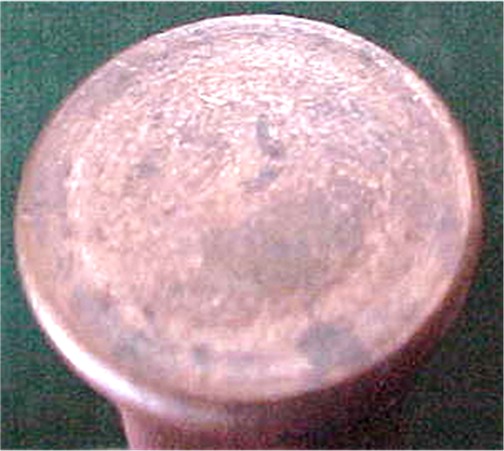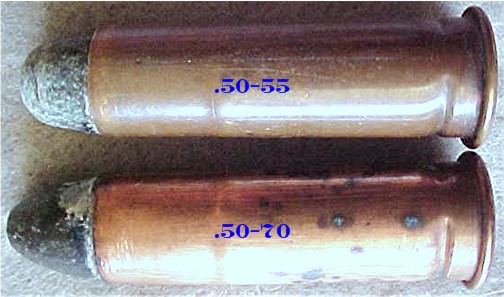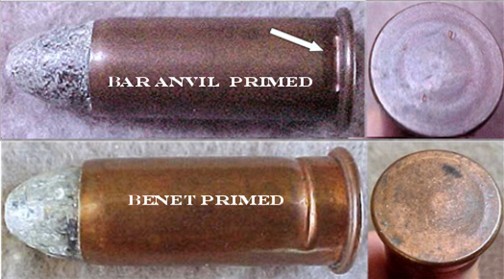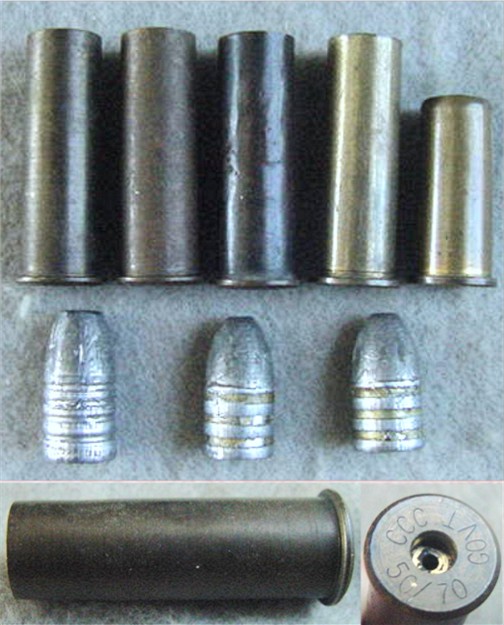| |
|
|
|
FRANKFORD ARSENAL INTERNALLY PRIMED .50-70 AND .50-45 BALL
AND BLANK CARTRIDGES - EARLY INDIAN WAR ERA CARTRIDGES
ca. 1866 -1873: The standard US Army
cartridge for all the carbines and rifles (with the
exception of the Spencer Arms) issued between 1866 and
1873, the .50-70 was the primary cartridge issued to the
post-Civil War Frontier Army. This historic
cartridge was not only in use by the soldiers at
famous battle sites such as the Wagon Box Fight, but was
also extensively used by the hide hunters during the
early days of the buffalo slaughter on the plains in
Kansas and Texas.
The early
production, internally primed .50-70, .50-55, and .50-45 cartridges were
never available in large quantities and as the years
have passed, they are becoming harder and harder to find
on the loose.
NOTE: On
occasion, I am able to acquire the rare Frankford
Arsenal Martin and Berdan primed .50-70 Ball Cartridges, Frankford Arsenal .50-70 Blank Cartridges,
Frankford Arsenal .50-55 Carbine Cartridges, Frankford
Arsenal .50-45 Carbine Cartridges, and a variety of .50
caliber military contract cartridges, and when
in stock, they will be listed below.
I have the
following ball service cartridges and blank cartridges
in stock, each listed individually below with
accompanying photographs.
|
|
No. 1
.50/70 FRANKFORD ARSENAL
BENET PRIMED BALL CARTRIDGE:
These .50-70 Internally Primed Centre Fire Cartridges,
manufactured by the Frankford Arsenal, are individual
collector quality cartridges used by the soldiers during
the early Indian Wars Period. These are becoming
increasingly difficult to find on the loose and soon the
available stocks will be exhausted. $55 each
 |

No.
2
“US
CARBINE”
.50/55 FRANKFORD ARSENAL
BENET PRIMED BALL CARTRIDGE:
Manufactured by the Frankford Arsenal for a relatively
short period, and apparently in very limited numbers,
these “UNITED STATES CARBINE” .50-55 Internally Primed
Centre Fire Cartridges are quite scarce today.
Introduced in 1870 or 1871,
these cartridges were loaded with a reduced charge and
lighter bullet – 55 grains of powder and a 430 grain
bullet versus the 70 grains of powder and 450 grain
bullet in the standard 50-70 cartridges. Intended for
use in all of the 1870 Trial Carbines, this loading was
as short lived as the Trial guns, and was soon
supplanted by the adoption of the .45 caliber arms in
1873.
As the units on the frontier
kept some of the .50 caliber guns in their unit
inventories after they received the .45 caliber arms and
used the older guns for hunting and for issue to scouts
and packers, the .50-55 ammunition which was delivered
to the frontier was certainly expended, leaving few
examples to survive into the modern collector market.
When compared to the standard
.50-70 cartridge as seen below in the photograph, these
.50-55 cartridges are remarkably different and
considerably more difficult to find than the .50-70. I
have found a very small number of these .50-55
cartridges and they would be a nice addition to display
with your early Indian War carbine – one that is found
in very few but the most advanced collections.
(0413) $95
 |
|
COMPARISON OF BENET AND BAR ANVIL PRIMED CARTRIDGES
No. 3 .50-70 FRANKFORD
ARSENAL BAR ANVIL PRIMED CARTRIDGE: A Frankford Arsenal loading of the .50-70, this
cartridge is fitted with the bar anvil priming system,
evidenced by the primer crimp immediately above the rim
of the cartridge case. (0408) $65

No.
3 a .50-45 FRANKFORD
ARSENAL BAR ANVIL PRIMED CARTRIDGE:
An excellent example of a fairly scarce variant as
compared to the more common Benet primed
cartridges.
SOLD

No.
3 b .50-45 FRANKFORD
ARSENAL BAR ANVIL PRIMED CARTRIDGE: This one was subjected to a
firing pin strike leaving an indent in the cartridge
head, but nonetheless, this is a fairly scarce variant as
compared to the more common Benet primed
cartridges. (0725) $45
 |
|
No.
4
.50/70 FRANKFORD ARSENAL
BENET
INTERNALLY
PRIMED BLANK CARTRIDGE:
During the
Indian Wars period blank ammunition
was regularly provided to the Cavalry troops, used to
accustom the horses to gun fire, and to the Infantry for
ceremonial occasions and funerals. The same blank
cartridge was used in both the carbines and rifles.
Manufactured at the Frankford
Arsenal, these .50-70 caliber blanks were an integral component of the
standard issue of ammunition to the frontier soldier and
they have a rightful place in any Indian War ammunition
display. Far scarcer than the Spencer or later
.45-70 blank cartridges, these are the first I have had
in some time. In excellent condition. $55

|
|
No.
5 .50/70
WINCHESTER REPEATING ARMS CARTRIDGE: Circa
1870-1880 loading produced by the Winchester Repeating
Arms Company for sale on the buffalo hunting range and
across the frontier. An excellent specimen of a
scarce cartridge with a
very legible headstamp. (10109) $50
 |
|
No.
6 .50/70
BOXER PRIMED BALLOON HEAD CARTRIDGE - AN EARLY LOADING
AS PRODUCED BY SHARPS, UMC OR US CARTRIDGE COMPANY : The lack of
a headstamp on this .50-70 Boxer primed cartridge
suggests this was an early production cartridge, and of
the type produced by the Sharps, UMC and U.S. Cartridge
Company and sold on the frontier to the buffalo hunters.
In excellent condition, I have a few of these so if
you're trying to fill a box, act soon. (0214) $25
each

|
|
No.
7 REMINGTON-UMC .50/70
BALL CARTRIDGE: An early commercially
produced cartridge, the small font headstamp is
indicative of the type of Remington cartridges sold out
on the frontier while it was still a frontier, and would have been marketed to the
professional hunters. A fairly scarce and
historically significant example. (10113) $30

|
|
No.
8
.50/70
COMMERCIAL EXTERNALLY
PRIMED SHOT CARTRIDGES:
During the
frontier period shot cartridges were marketed for a
number of the larger bore rifles to enable the shooter
to use the rifle for gathering small game and birds for
the larder. These three are good examples of these
shot cartridges and when displayed with a .50-70 rifle
will illustrate another dimension of their use on the
frontier.
This set includes one long unfired
Remington- UMC, one fired Remington-UMC, and one shorter
UMC headstamped ".50-70 Carbine". Offered her as a
set, (0616) $30 for all three
  
|
|
No.
9 MODERN 50/70
CARTRIDGE CASES:
Here of late I've had several inquiries for reloadable
.50-70 cartridge cases. From what I'm being told,
this and other frontier era cartridge cases are becoming
difficult to find on the market, so when the opportunity
presented, I picked up this group. There are four
full length .50-70 cartridge cases, one 50-45 case, and
the three lead bullets shown. If you anneal these
before using them, you'll be able to get quite a few
loadings out of them before they begin to show any wear.
(0306) $50 for
this group

|
|
No.
10 EARLY
REMINGTON .50/70
BOXER PRIMED BALL CARTRIDGE WITH THE "E. REMINGTON &
SONS" HEADSTAMP: An early commercially
produced cartridge, this is the type Remington sold out
on the frontier and would have been marketed to the
professional buffalo hunters. A fairly scarce and
historically significant example.
SOLD

|
|
No.
11 .50/70 FRANKFORD ARSENAL
MARTIN PRIMED BALL CARTRIDGE:
Manufactured by the Frankford Arsenal, this .50-70
Martin Primed cartridge is one of the rarer Indian War
cartridges of the period. The standard cartridge
design for a very short period, the cartridge case was
formed with an integral primer pocket which held an
internal primer, and in spite of its appearance, could
not be reloaded as was possible with the Berdan primed
cases. By comparison, these Martin primed
cartridges are considerably rarer than the early .45-70
Benet primed cartridges without a headstamp. In
excellent condition.
SOLD

|
|
No.
12 .50/70
FRANKFORD ARSENAL INTERNALLY PRIMED BALL CARTRIDGE WITH
VERY RARE FRANKFORD ARSENAL HEADSTAMP: One
of the rarest of the Frankford Arsenal produced .50-70
cartridges, these bearing the standard arsenal headstamp
in the same format as the internally primed .45-70
cartridges, were produced for issue to scouts, packers,
and other auxiliary personnel who supported the columns
of soldiers, and it is likely these cartridges were made
available to militia units and academies who were armed
with the earlier .50 caliber Trapdoor arms. An
excellent specimen with a clear legible headstamp.
SOLD
 |
|
|
|
|
|
|
|
|
|
|

